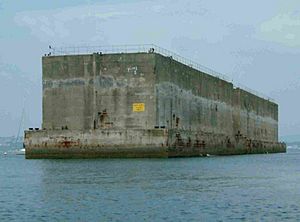Ove Arup facts for kids
Quick facts for kids
Ove Arup
|
|
|---|---|
 |
|
| Born | 16 April 1895 Newcastle upon Tyne, England
|
| Died | 5 February 1988 (aged 92) London, England
|
| Nationality | English |
| Citizenship | British |
| Education | Sorø Academy University of Copenhagen Polyteknisk Læreanstalt |
| Occupation | Engineer |
| Spouse(s) | Ruth Sørensen |
| Parent(s) | Jens Simon Johannes Arup Mathilde Jolette Nyquist |
| Engineering career | |
| Discipline | Structural engineer |
| Institutions | Institution of Structural Engineers |
| Practice name | Arup |
| Projects | Sydney Opera House Centre Pompidou Kingsgate Bridge Highpoint I Labworth Café |
| Awards | IStructE Gold Medal RIBA Gold Medal |
Sir Ove Arup (born April 16, 1895 – died February 5, 1988) was a famous English engineer. He started a company called Arup. This company helps design and build many different things, like buildings and bridges. Ove Arup was known as one of the best structural engineers of his time.
Contents
Early Life and Learning
Ove Arup was born in Newcastle upon Tyne, England, in 1895. His father was a Danish animal doctor, and his mother was Norwegian.
He went to Sorø Academy in Denmark. This was a boarding school, which means students lived there.
In 1913, he started studying philosophy at the University of Copenhagen. Later, in 1918, he decided to study engineering. He went to the Technical University of Denmark and focused on reinforced concrete. This is a strong building material made of concrete with steel bars inside. He finished his studies in 1922. During this time, he was inspired by famous architects like Le Corbusier and Walter Gropius.
Ove Arup married Ruth Sørensen, who was also known as Li, on August 13, 1925.
Working as an Engineer
Before World War II
In 1922, Ove Arup started working for a Danish company in Germany. In 1923, he moved to their London office and became the chief engineer.
He designed the Labworth Café in England. This café is special because it's the only building that Arup designed completely by himself.
He then worked as a structural consultant for a group called Tecton. A structural consultant helps make sure buildings are strong and safe. He worked on famous projects like the Penguin Pool at the London Zoo. He also worked on Highpoint I, a tall apartment building. He had a very close working relationship with Berthold Lubetkin, a main partner at Tecton.
From 1934 to 1938, he worked for a construction company in London. He also worked with other well-known architects during the 1930s.
In 1938, he and his cousin Arne started their own company, Arup & Arup Limited. It was a company of engineers and builders.
During World War II
Before World War II, Ove Arup helped plan for Air Raid Precautions. He gave advice on how to build bomb shelters. During the war, he wrote papers about how to make strong concrete shelters. He believed these large shelters were better than many small ones.
Arup played a very important part in designing the Mulberry temporary harbours. These were special floating harbours used during the D-Day landings in 1944. The parts of these harbours were built in Britain. Then, they were taken across the English Channel and put together off the coast of France. This allowed the Allied forces to bring supplies and troops to the beaches during the invasion.
Arup and Partners Company

After the war, in 1946, Ove Arup started a new company. It was a team of engineers who advised on civil and structural projects. He formed his first partnership with other engineers, calling it Arup and Partners.
Later, in 1963, another company called Arup Associates was created. This company had architects and engineers working together as a team. They provided many services for building projects. Eventually, all the different Arup companies became known simply as Arup.
Famous Projects
Highpoint I
Highpoint I was built in 1935. It was an important building because it was an early example of a tall apartment building. It was one of Arup's most important projects with Berthold Lubetkin.
Kingsgate Bridge

Ove Arup personally watched over the design and building of Durham's Kingsgate Bridge in 1963. This was the first bridge his company built. Arup loved this project very much. After he passed away, his ashes were scattered from this bridge. A statue of Arup was placed at one end of the bridge. Kingsgate Bridge was the last structure Arup designed himself.
Van Ginkel Footbridge
The Van Ginkel Footbridge is in Bowring Park, Canada. It is a special type of bridge called a cantilever bridge. This means it is only attached to the ground on one side, and the other side hangs over the space. The bridge was recognized as a historic landmark in 2020.
Sydney Opera House
Arup was the main engineer for the Sydney Opera House in Australia. He worked on it from 1957 until it was finished in 1973. This building is famous for its unique design and how it used precast concrete. It also used new ways of analyzing structures with computers. This project made Arup and his company very well-known, even though working with the architect, Jørn Utzon, was sometimes difficult.
Awards and Honors
- 1953: Received the Commander of the Order of the British Empire (CBE) award.
- 1965: Became a Knight of the Order of the Dannebrog in Denmark.
- 1966: Awarded the Royal Gold Medal by the Royal Institute of British Architects.
- 1971: Became a Knight Bachelor in the United Kingdom.
- 1973: Received the Gold Medal from the Institution of Structural Engineers.
- 1975: Became a Knight Commander of the Order of the Dannebrog.
- 1976: Received an honorary doctorate from Heriot-Watt University.
- 1987: Became a Royal Academician.
|
See also
 In Spanish: Ove Arup para niños
In Spanish: Ove Arup para niños


